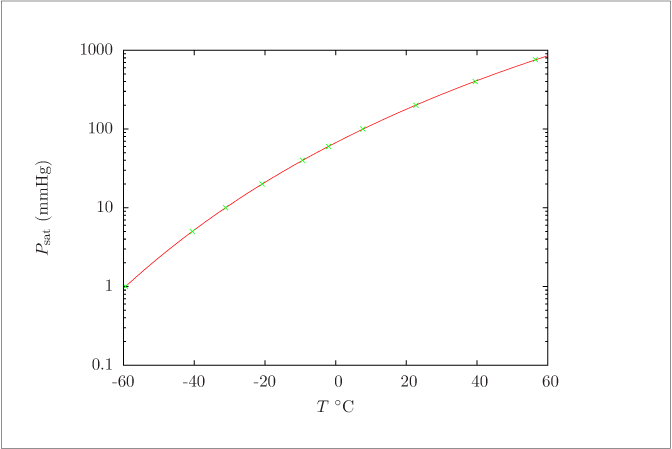Figure 10 (page 20):
Antoine model fitted to the acetone vapor pressure data of Example \ref {ex:AntoineFit}.

Code for Figure 10
Text of the GNU GPL.
main.m
clear('all'); close('all');
% Vapor pressure values (data?) from Perry's 7th Table 2-8 p. 2-61.
% Psat [=] mmHg, T [=] degC
% The table values seem to have been smoothed, perhaps even with Antoine.
% Should add some noise...
data = [ -59.4 1 ; ...
-40.5 5 ; ...
-31.1 10 ; ...
-20.8 20 ; ...
-9.4 40 ; ...
-2.0 60 ; ...
7.7 100 ; ...
22.7 200 ; ...
39.5 400 ; ...
56.5 760 ] ;
Psat = data(:,2);
T = data(:,1);
% Error for pressure is given as a relative error (2 %). This is
% equivalent to an absolute error in the log of the value. Therefore, we
% will chose to fit y = f(x,theta), taking y = ln Psat and x = T.
sigmax = 0.2;
sigmay = 0.02; % This is an approximation, good enough in this situation.
% (Could use log(1.02) .)
% Both data and Antoine function give pressure values, not logs, so
% define a function handle for ln Psat and compute log of data values
lnPsat = @(T, theta) log( Antoine(T, theta) );
y = log(Psat);
% Define a function handle for the minimization objective.
% theta is a row vector, T is a column, so make
% X = [ theta, xhat' ]
% with theta = [ A, B, C ]
% First look carefully at how we constructed function SS.
% Then make the function handle phi so SS(...) can be called in the form phi(X):
phi = @(X) SS( lnPsat, X(1:3), y, T, X(4:end)', sigmay, sigmax) ;
% Initial estimates for xhat
xhat0 = T;
% Initial estimates for parameters A, B, C
A = 16.8
B = -2994
C = 238
theta0 = [ A; B; C ];
X0 = [ theta0; xhat0 ];
%options = optimset( 'MaxFunEvals', 1000, 'TolFun', 1.e-16, 'TolX', 1.e-6);
options = optimset( 'TolFun', 1.e-16, 'TolX', 1.e-16 );
[ X, SSmin ] = fminsearch( phi, X0, options );
% Report Antoine coefficients
theta = X(1:3);
A = theta(1)
B = theta(2)
C = theta(3)
% Report average scaled error
ase = sqrt( SSmin/(length(Psat) - 3) );
disp('Average scaled error:'), disp(ase)
disp('Predicted error in T:'), disp(ase*sigmax)
disp('Predicted relative error in Psat:'), disp(ase*sigmay)
% Plot
semilogy( T, Psat,'ob' )
ylabel('Psat, mmHg')
xlabel('T, deg C')
hold on
fplot( @(T) Antoine(T, theta), [ -60, 60 ] )
% save results to file for plotting
Tplot = linspace(-60, 60, 100)';
Pplot = Antoine(Tplot, theta);
save acetone_data.dat data;
fit = [Tplot, Pplot];
save acetone_fit.dat fit
Antoine.m
function Psat = Antoine(T, theta)
% Computes the vapor pressure using the Antoine model
%
% ln Psat = A + B/(T + C)
%
% theta = [ A, B, C ]
A = theta(1);
B = theta(2);
C = theta(3);
Psat = exp( A + B./(T + C) );
SS.m
function result = SS( f, theta, y, x, xhat, sigmay, sigmax)
% Sum of squares function
% yhat = f(xhat,theta). Multiple output variables are row vectors.
% y, x = observed values
% xhat = fitted values of x. Multiple inputs variables are in rows.
% theta = parameters
Ny = size(y,2);
Nx = size(x,2);
K = size(y,1);
% Nested loops sum over observations, xhat's, yhat's:
result = 0.;
xhat = xhat.';
for k = [1 : K]
yhat = f(xhat(k,:), theta);
for i = [1 : Ny ]
eps = (yhat(i) - y(k,i))/sigmay(i);
result = result + eps*eps;
end
for j = [1 : Nx ]
eps = (xhat(k,j) - x(k,j))/sigmax(j);
result = result + eps*eps;
end
end
